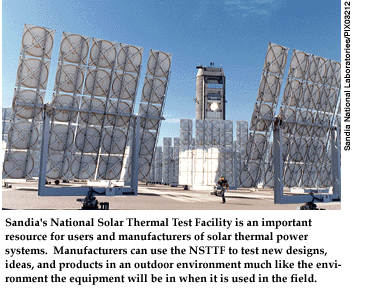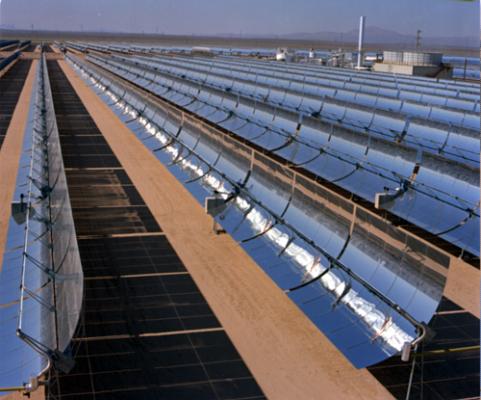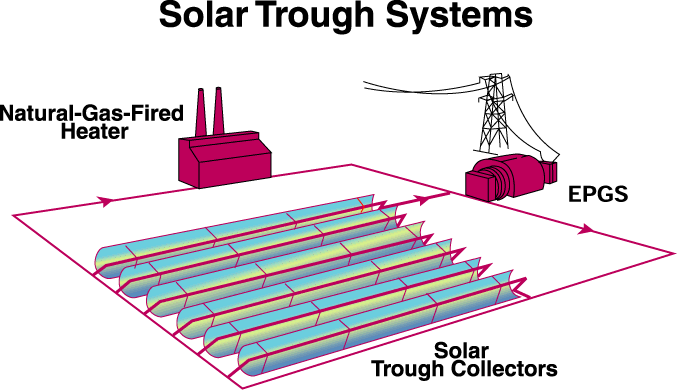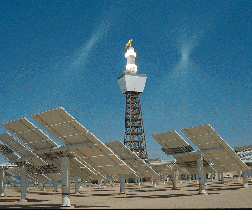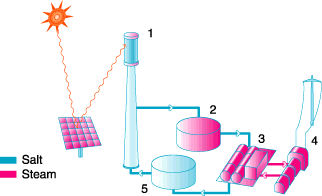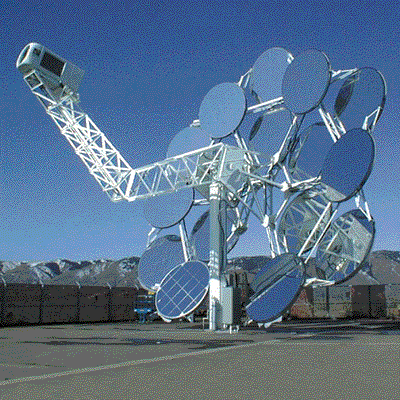Solar Power Plant |
||
| Week 1 Solar Power Plant We are going to use the solar power plant as our first study case for the analysis of a complete thermal system. Throughout this class, and the second class as well, we are going to revisit this system over and over again. The main purpose is to provide you an integrated view of the entire system and to show the connectivity between different disciplines in thermal science. What is a solar power plant? Go visit SunLab and other Internet links to learn more
about it. Technology Relevant Subjects
Fluid Mechanics
Thermodynamics
Why solar energy? Clean, Abundance, renewable & getting cheaper Other renewable energy sources
|
Trough systems predominate among today’s commercial solar power plants. Trough systems convert the heat from the sun into electricity. Because of their parabolic shape, troughs can focus the sun at 30 to 60 times its normal intensity on a receiver pipe located along the focal line of the trough. Synthetic oil captures this heat as the oil circulates through the pipe, reaching temperatures as high as 390°C (735ºF). The hot oil is pumped to a generating station and routed through a heat exchanger to produce steam. Finally, electricity is produced in a conventional steam turbine.
Solar Power TowersThese systems produce electricity on a large scale. They are unique among solar technologies because they can store energy efficiently and cost effectively. They can operate whenever the customer needs power, even after dark or during cloudy weather. Power towers operate by focusing a field of thousands of mirrors onto a receiver located at the top of a centrally located tower. The receiver collects the sun's heat in a heat-transfer fluid, which is used to generate steam for a conventional steam turbine located at the foot of the tower for production of electricity.
Solar Dish/Engine Systems
These systems, with net solar-to-electric conversion efficiencies reaching 30%, can operate as stand-alone units in remote locations or can be linked together in groups to provide utility-scale power Solar dish/engine systems convert the energy from the sun into electricity at a very high efficiency. Using a mirror array formed into the shape of a dish, the solar dish focuses the sun’s rays onto a receiver. The receiver transmits the energy to an engine, typically a kinematic Stirling engine (although Brayton-cycle engines are also being considered), that generates electric power. Because of the high concentration ratios achievable with parabolic dishes and the small size of the receiver, solar dishes are efficient at collecting solar energy at very high temperatures. Tests of prototype systems and components at locations throughout the United States have demonstrated net solar-to-electric conversion efficiencies as high as 30%. This is significantly higher than any other solar technology.
|
|
